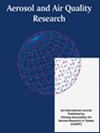大气细颗粒物改善的意义——以台湾北部新冠肺炎大流行为例
IF 2.5
4区 环境科学与生态学
Q3 ENVIRONMENTAL SCIENCES
引用次数: 1
摘要
2019冠状病毒病疫情在台湾北部爆发,导致2021年实施三级预警措施,从而对空气质量产生重大影响,这为更好地了解未来空气污染物的控制策略提供了前所未有的机会。本研究全面调查了PM2.5的来源、化学特征和人体健康风险的变化。PM2.5质量浓度从预警到三级预警下降了49.4%,无机离子NH4+、NO3-和SO42-的降幅更大,分别下降了71%、90%和52%。而有机质(OM)和单质碳(EC)分别下降了36%和13%,这导致PM2.5的化学成分发生变化,PM2.5中的碳质物质取代无机离子占主导地位。基于相关性的聚类分析进一步表明,PM2.5在3级预警期间与碳质物质聚集在一起,而在预警前后与无机离子聚集在一起。此外,通过正矩阵分解(PMF)识别出PM2.5的6个来源,其中二次硝酸盐(即老化的交通气溶胶)的减少最为显著,而以碳质物质为主的交通相关的一次排放变化不显著。这意味着当交通量下降时,与二次交通相关的气溶胶可以很容易地控制,而未来主要交通源需要更多的努力,特别是碳质物质的减少。因此,汽车仍然需要更清洁的能源。PM2.5中微量元素诱发的致癌风险和非致癌风险评估均出现了不显著的下降,这可以归因于在三级预警期间没有关停的工厂。这项研究可以作为未来空气污染缓解策略的一个指标,并强调了碳质物质对减少PM2.5的重要性。本文章由计算机程序翻译,如有差异,请以英文原文为准。
Implications of the Improvement in Atmospheric Fine Particles: A Case Study of COVID-19 Pandemic in Northern Taiwan
The outbreak of COVID-19 pandemic in northern Taiwan led to the implementation of Level 3 alert measures during 2021 and thereby impacted the air quality significantly, which provided an unprecedented opportunity to better understand the control strategies on air pollutants in the future. This study investigated the variations in sources, chemical characteristics and human health risks of PM2.5 comprehensively. The PM2.5 mass concentrations decreased from pre-alert to Level 3 alert by 49.4%, and the inorganic ions, i.e., NH4+, NO3- and SO42-, dropped even more by 71%, 90% and 52%, respectively. Nonetheless, organic matter (OM) and elemental carbon (EC) simply decreased by 36% and 13%, which caused the chemical composition of PM2.5 to change so that the carbonaceous matter in PM2.5 dominated instead of the inorganic ions. Correlation-based hierarchical clustering analysis further showed that PM2.5 was clustered with carbonaceous matter during the Level 3 alert, while that clustered with inorganic ions during both pre-alert and post-alert periods. Moreover, 6 sources of PM2.5 were identified by positive matrix factorization (PMF), in which secondary nitrate (i.e., aging traffic aerosols) exhibited the most significant decrease and yet primary traffic-related emissions, dominated by carbonaceous matter, changed insignificantly. This implied that secondary traffic-related aerosols could be easily controlled when traffic volume declined, while primary traffic source needs more efforts in the future, especially for the reduction of carbonaceous matter. Therefore, cleaner energy for vehicles is still needed. Assessments of both carcinogenic risk and non-carcinogenic risk induced by the trace elements in PM2.5 showed insignificant decrease, which can be attributed to the factories that did not shut down during Level 3 alert. This study serves as a metric to underpin the mitigation strategies of air pollution in the future and highlights the importance of carbonaceous matter for the reduction in PM2.5.
求助全文
通过发布文献求助,成功后即可免费获取论文全文。
去求助
来源期刊

Aerosol and Air Quality Research
ENVIRONMENTAL SCIENCES-
CiteScore
8.30
自引率
10.00%
发文量
163
审稿时长
3 months
期刊介绍:
The international journal of Aerosol and Air Quality Research (AAQR) covers all aspects of aerosol science and technology, atmospheric science and air quality related issues. It encompasses a multi-disciplinary field, including:
- Aerosol, air quality, atmospheric chemistry and global change;
- Air toxics (hazardous air pollutants (HAPs), persistent organic pollutants (POPs)) - Sources, control, transport and fate, human exposure;
- Nanoparticle and nanotechnology;
- Sources, combustion, thermal decomposition, emission, properties, behavior, formation, transport, deposition, measurement and analysis;
- Effects on the environments;
- Air quality and human health;
- Bioaerosols;
- Indoor air quality;
- Energy and air pollution;
- Pollution control technologies;
- Invention and improvement of sampling instruments and technologies;
- Optical/radiative properties and remote sensing;
- Carbon dioxide emission, capture, storage and utilization; novel methods for the reduction of carbon dioxide emission;
- Other topics related to aerosol and air quality.
 求助内容:
求助内容: 应助结果提醒方式:
应助结果提醒方式:


